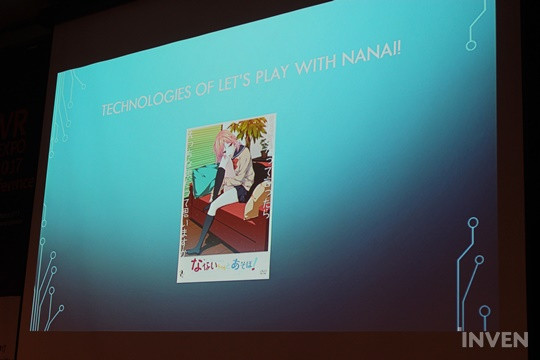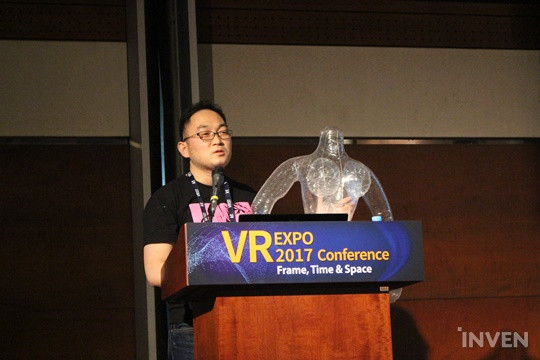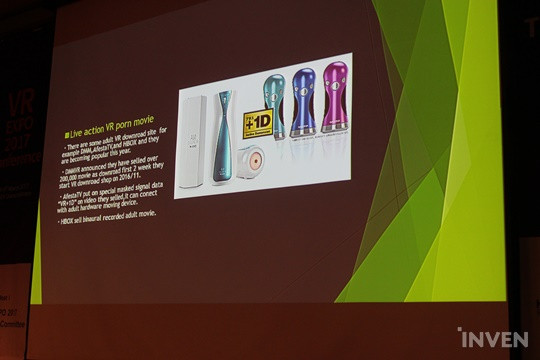
Working in the game industry myself, the first thing I think of when I see Japan is its video game industry, with Sony and Nintendo leading the way. Of course, that’s not the only thing they are famous for; they are also the leaders of the industry when it comes to adult contents.
While I am not entirely sure such a point of view made me focus more on certain things than others, we were actually able to see a lot of Japanese VR content made for mature audiences. Not only adult VR videos, but also adult VR games. This is definitely not something you would be able to see in Korea, or even imagine being there. Then I wondered, how promising would Japan’s adult VR game market be?
Programmer ROBA and representative Kaicho (Kaicho means CEO in Japanese) from VRJCC, the studio that made “Let’s Play with Nanai”, stood at the podium to answer such question. Let’s hear what they had to say about the reason why they made an adult VR game, and also what the future of the Japanese VR market would be for adult VR games.

Introducing the technology behind “Let’s Play with Nanai!”
“Let’s Play with Nanai,” as you can see, is an adult VR game. What makes this game so special is that the game’s controller is a dutch wife. Yes, the dutch wife you have sex with. The reason behind that is simple; “Let’s Play with Nanai!” is designed to give you diverse experiences according to the dutch wife’s position. This is something other adult VR games have been missing out.
In order to establish this unique controlling system, VRJCC used a motion capture method called Perception Neuron along with the Unity engine. The team also used a specific type of VR camera to provide a more immersive experience.

Why did VRJCC go so far as to make its own controller based on a dutch wife? ROBA explained that the reason is simple. When they had just begun working on the project in 2015, there were no VR controllers like we have with the Oculus or Vive nowadays, needless to mention that they were still unfamiliar with the concept of VR.
Due to such reasons, they first tried to make a controller based on a smartphone. The game still uses a smartphone for controls, but it was different back then because the player had to use a smartphone to move in the game instead of attaching it to the dutch wife. The reason why they chose a smartphone was simple: the device already has a built-in gyro sensor and accelerometer. The wide use of smartphones among many people also meant that they did not have to purchase additional devices to play the game. Using a smartphone as the game’s controller meant that potential players already had what they needed to play the game.

Then, one day, ROBA’s friend told him that it would be better to shift the game’s focus towards making the dutch wife move instead of the player. He thought it was a good idea, and created the dutch wife controller as we see it now. This dutch wife controller uses a smartphone’s gyro sensor and accelerometer to apply the dutch wife’s posture and movement to the game.

The in-game posture and movements were rendered through the motion capture system called Perception Neuron. Perception Neuron come at a cheap price of about 1,600 dollars, making it a favorable option for the devs of VRJCC that did not receive much funding. Other types of motion capture systems often cost over 20,000 dollars.
Of course, the cheap price of Perception Neuron came with its own drawbacks. It was not as precise as other motion capture devices, but vaguely rendered simple body movements like skeletal motion and the body’s angle.

This made it the developers’ job to tweak more detailed action that Perception Neuron could not capture. ROBA, upon recalling the days when he had to fix every “noise,” (unnecessary movements) shuddered with disgust saying, “I don’t want to do that ever again in my life.”
Now that the devs had their controller and motion ironed out, they had to deal with the VR camera. Normally a VR camera films all 360 degrees, but ROBA thought they did not have to do that because people tend to focus only on what is in front of them when it comes to adult VR. Common VR cameras also caused distortion when they rendered adult content, so the team decided to use a VR camera specifically designed for adult VR. This type of camera caused distortion when the user turned his or her head sideways. However, that was not much of a concern in adult VR, because the background did not matter as much as what is in front of you.

Such experimental approaches enabled “Let’s Play with Nanai!” to come out to this world. VRJCC is planning to further develop the game and add more options in body movements while also adapting the game to other controllers.
Why did VRJCC make an adult VR game?

Kaicho explained why VRJCC decided to make an adult VR game, and he started by explaining Japan’s adult VR market. Japan’s VR market largely falls into two categories, which are VR videos and VR games, as is also the the case in most other countries.
VR videos are gaining popularity among Japanese consumers, but the category has its own restrictions that prevent it from fully utilizing what VR is really capable of. It is, after all, a 360-degree video without interaction with the viewer. So far in Japan, AfestaTV made the most interactive adult VR videos by connecting it to the male masturbator.

It sure is interesting that AfestaTV’s masturbators are gaining popularity among consumers. This shows that VR consumers want to go further than simply watching the video, they want to step in and interact.
This encouraged VRJCC to make “Let’s Play with Nanai.” As a whole, they lacked experience with both game development and eroge. Still, they decided to take on a challenge when they realized that the market was a new frontier without much breakthrough, and it has so far been successful according to Kaicho.
“Adult games have featured different body postures and actions, but players had to start over when they wanted to change the position. This is what makes “Let’s Play with Nanai!” so special, because you can change position on the fly as you progress through the game. As far as we know, there were no such games like this yet.
Of course, there is still much room for improvement in “Let’s Play with Nanai!” A lot of the actions are still motionless, and there are not many positions to play around with, but these issues can be improved as the team makes further progress in developing the game. Kaicho, as he wrapped up his presentation, said, “Other companies can catch up with the types of technology we introduced today, but I assume we are in the lead as of now,” reasserting his desire to further improve the game.

Sort by:
Comments :0







